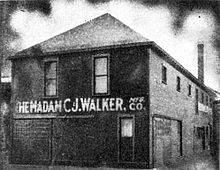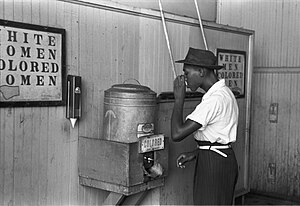Federal Writers' Project – Life Histories/2021/Summer/105/Section 06/Ned Davis
Federal Writers' Project – Life Histories/2021/Summer/105/Section 06/Ned Davis | |
|---|---|
| Born | Aug 13, 1897 in DeRamus County, South Carolina |
| Died | Unknown |
| Nationality | African-American |
| Occupation | Beauty Shop Owner |
| Spouse(s) | Ila May, Mabel Langford |
 Madam C. J. Walker Manufacturing Company (1911). A famous black-owned beauty company. |
Ned Davis
[edit | edit source]Overview
[edit | edit source]Ned Davis was a beauty shop owner in Charlotte, North Carolina in the 1920-40s.[1] He was one of the first African-Americans in the NC beauty industry to receive state certification for his business.[2] On May 3, 1939, Davis sat down with interviewers Cora Lee Bennett and Mary R. Northrop of the Federal Writers’ Project to share his life story.
Biography
[edit | edit source]Early Life
[edit | edit source]Davis was born on August 13, 1897 in South Carolina[3]. He was raised by his father, grandmother, and stepmother, and had no siblings.[4] According to Davis, his father was a sharecropper who did not value education.[5] Davis’s mother, however, wanted him to learn to read and write, so he attended school up to third grade.[6] After dropping out of school, he began working as a servant with his stepmother. In those house jobs, Davis claimed in his interview, he learned proper manners and sophistication.[7] As a child, Davis was often complimented for his great charisma and character.[8] As an adult, an employer described him as trustworthy and curious.[9] In addition, Davis spent many hours watching his stepmother treat the hair of her clients, which, he said, caused him to develop an interest in beauty products. [10]
Family Life
[edit | edit source]Upon reaching adulthood, Davis married for the first time to a woman named Ila May Brevard.[11] Davis had lived in rural country his whole life, but soon after marrying he moved to an urban city with his wife. Moving to the city presented a challenging new way of life for Davis, but he claimed that his wife helped him adjust very well.[12] Davis and his wife had their first child together a year after they married. The child’s health was poor early on, which troubled them.[13] Davis had not been raised in a religious family, but he decided to attend church one day to manage his distress.[14] The first Sunday service he attended resonated so deeply with him that he felt immediately converted.[15] A couple years later, Davis and his wife had a second child. His wife became sick after giving birth and she died after about three months. While recounting this event during his interview, Davis said, “I was heartbroken; left with two small children and had no idea what to do with them.”[16] He believed he would never love another woman.[17] However, he soon fell in love with his coworker, Mabel Langford, and they were married six weeks after the death of his first wife[18]
Career
[edit | edit source]Since his education ended at just third grade, Davis worked many jobs before reaching adulthood. Davis believed he had amassed a great deal of business knowledge and experience from the diversity of his jobs, which ranged from threshing grain and road construction to cooking and chauffeuring.[19] In early adulthood, his next series of jobs included working in a car garage, dining room, carnival, and hotel.[20] After establishing a family with his second wife and two children, Davis moved to Charlotte, NC and started a business around what he claimed to be his true passion: hair products.[21] He applied and received a patent for his self-created hair grower product.[22] Davis had spent a significant portion of his savings to produce the hair grower, but the product did not bring much success early on.[23] His family began to struggle financially. To avoid bankruptcy, Davis sold whiskey illegally and made a considerable amount of money before getting caught and arrested.[24] Using his charisma, Davis lied and escaped with only a $75 fine.[25] He stopped selling whiskey after that and refocused on building his beauty business.[26] The next year, Davis’s Caravan Touch Up product became extremely popular, by his standards, and was sold in 26 US states.[27] Davis recalls that in 1933 North Carolina established certification procedures for the beauty industry.[28] Davis was one of the first African-Americans to be certified, and his Negro Beauty School was the first beauty school for African-Americans in NC.[29] From 1933 to 1938, over 100 students attended his beauty school. In 1938, the school was changed to “The Servants Clinic,” with the purpose of educating and empowering African-Americans to build better lives for themselves and their families.[30] The school system of his time, Davis believed, instilled limited beliefs in African-American children.[31] In the final moments of his interview, Davis reflected, “I have made my contribution to my race.”[32] The events of his life following his interview with Bennett and Northrop in 1939 are unknown.
Social Issues
[edit | edit source]
Racial Discrimination in the Beauty Industry
[edit | edit source]The belief in white racial superiority had been widely accepted in North America for at least two hundred years leading up to the Great Depression.[33] This idea caused racial discrimination against African-Americans that impacted many American industries, especially the Beauty/Cosmetic industry, since its focus is on physical appearance.[34] In a History article analyzing the Great Depression’s effect on African-Americans, it states, “Prior to the Great Depression, African Americans worked primarily in unskilled jobs,” while after the Great Depression, “those entry-level, low-paying jobs either disappeared or were filled by whites in need of employment.”[35] Racial barriers existed not only for common workers, but for African-American business owners, as well. It was more difficult for them to obtain loans and market products in mainstream media.[36] Therefore, black manufacturers had to find alternative methods to compete in the beauty industry, like using unconventional marketing tactics and creating hair products for narrow groups of people.[37]
Black Education Funded by Northern Institutes
[edit | edit source]Southern schools for African-Americans were often funded by white-dominated Northern institutes from 1902-1930.[38] Due to this, Northern institutes largely controlled the curriculum taught to black children. A damaging practice in these schools was pushing discriminatory race roles.[39] An analyst of the southern black education system wrote, “Northern white liberals acquiesced in southern white racist beliefs and practices toward African Americans basically because of a shared belief in white cultural, if not ‘racial,’ superiority.”[40] This may have instilled in black children the belief that they could not achieve much success in their careers because they have been taught both implicitly and explicitly that they are inferior to whites. America was prosperous in the decades following the Great Depression, but the impact of the racist teachings in southern schools likely discouraged many African-Americans from creating success financially and in their careers.[41] Some educators recognized the danger of the public school system and sought to empower African-American children through private education.[42]
Footnotes
[edit | edit source]- ↑ Cora Bennett and Mary Northrop. “A Race Man Th’ough an’ Th’ough.” Federal Writers’ Project, Southern Historical Collection, The Wilson Library, University of North Carolina at Chapel Hill, no. 3709, (1936-1940): 1.
- ↑ Ibid., 16.
- ↑ Ibid., 2.
- ↑ Ibid., 2.
- ↑ Ibid., 2.
- ↑ Ibid., 2.
- ↑ Ibid., 4.
- ↑ Ibid., 9.
- ↑ Ibid., 9.
- ↑ Ibid., 3.
- ↑ Ibid., 7.
- ↑ Ibid., 7.
- ↑ Ibid., 10.
- ↑ Ibid., 10.
- ↑ Ibid., 10.
- ↑ Ibid., 11.
- ↑ Ibid., 11.
- ↑ Ibid., 11.
- ↑ Ibid., 1-17.
- ↑ Ibid., 1-17.
- ↑ Ibid., 1-11.
- ↑ Ibid., 12.
- ↑ Ibid., 12.
- ↑ Ibid., 13.
- ↑ Ibid., 13.
- ↑ Ibid., 13.
- ↑ Ibid., 14.
- ↑ Ibid., 16.
- ↑ Ibid., 16.
- ↑ Ibid., 16.
- ↑ Ibid., 16.
- ↑ Ibid., 16.
- ↑ V.P. Franklin. 2001. "Dangerous Donations: Northern Philanthropy and Southern Black Education, 1902-1930." The Journal of American History 88 (2) (09): 683.
- ↑ Andor Skotnes. "'Buy Where You Can Work': Boycotting for Jobs in African-American Baltimore, 1933-1934." Journal of Social History 27, no. 4 (1994): 575.
- ↑ Christopher Klein. 2018. “Last Hired, First Fired: How the Great Depression Affected African Americans.” History.Com. April 18, 2018.
- ↑ Andor Skotnes. "'Buy Where You Can Work': Boycotting for Jobs in African-American Baltimore, 1933-1934." Journal of Social History 27, no. 4 (1994): 583.
- ↑ Ibid., 577.
- ↑ V.P. Franklin. 2001. "Dangerous Donations: Northern Philanthropy and Southern Black Education, 1902-1930." The Journal of American History 88 (2) (09): 683.
- ↑ Ibid., 683-684.
- ↑ Ibid., 683.
- ↑ Stephen B. Plank. 1999. "Children of the Great Depression: Social Change in Life Experience." Contemporary Sociology 28 (5) (09): 551-552.
- ↑ Cora Bennett and Mary Northrop. “A Race Man Th’ough an’ Th’ough.” Federal Writers’ Project, Southern Historical Collection, The Wilson Library, University of North Carolina at Chapel Hill, no. 3709, (1936-1940): 16.
Bibliography
[edit | edit source]Bennett, Cora and Mary Northrop. “A Race Man Th’ough an’ Th’ough.” Federal Writers’ Project, Southern Historical Collection, The Wilson Library, University of North Carolina at Chapel Hill, no. 3709, (1936-1940): 1-17.
Franklin, V. P. 2001. "Dangerous Donations: Northern Philanthropy and Southern Black Education, 1902-1930." The Journal of American History 88 (2) (09): 683-684. http://libproxy.lib.unc.edu/login?url=https://www-proquest-com.libproxy.lib.unc.edu/scholarly-journals/dangerous-donations-northern-philanthropy/docview/224897777/se-2?accountid=14244.
Klein, Christopher. 2018. “Last Hired, First Fired: How the Great Depression Affected African Americans.” History.Com. April 18, 2018. https://www.history.com/news/last-hired-first-fired-how-the-great-depression-affected-african-americans.
Plank, Stephen B. 1999. "Children of the Great Depression: Social Change in Life Experience." Contemporary Sociology 28 (5) (09): 551-552. http://libproxy.lib.unc.edu/login?url=https://www-proquest-com.libproxy.lib.unc.edu/scholarly-journals/children-great-depression-social-change-life/docview/233584932/se-2?accountid=14244.
Silverman, Robert Mark. "The Effects of Racism and Racial Discrimination on Minority Business Development: The Case of Black Manufacturers in Chicago's Ethnic Beauty Aids Industry." Journal of Social History 31, no. 3 (1998): 571-97. Accessed July 15, 2021. http://www.jstor.org/stable/3789715.
Skotnes, Andor. ""Buy Where You Can Work": Boycotting for Jobs in African-American Baltimore, 1933-1934." Journal of Social History 27, no. 4 (1994): 571-597. Accessed July 15, 2021. http://www.jstor.org/stable/3789081.